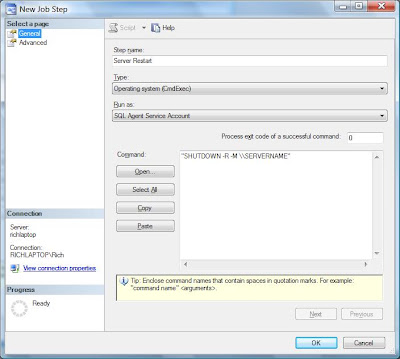
(schedule as required)
use msdb go select sysjobs.name, sysjobsteps.command from sysjobs inner join sysjobsteps on sysjobs.job_id = sysjobsteps.job_id where command like '%searchstring%' order by name




























SELECT DATEADD(dd, DATEDIFF(dd, '1900-01-01', GETDATE()),'1900-01-01')
SELECT DATEADD(dd, DATEDIFF(dd,0,GETDATE()), 0)
SELECT CAST(FLOOR(CAST(GETDATE() AS FLOAT)) AS DATETIME)
DECLARE @TabName varchar(255) DECLARE @ConstName varchar(255) DECLARE @SQL nvarchar(255) DECLARE @Cnt as int DECLARE @DBNAME as varchar(255) SET @DBNAME = '' use (databasename) DECLARE Const_cursor CURSOR FOR SELECT O_Table.[Name], O_Const.[Name] FROM sysConstraints C INNER JOIN sysObjects O_Table ON O_Table.[ID] = C.[ID] INNER JOIN sysobjects O_Const ON O_Const.[ID] = C.ConstID WHERE O_Const.[Name] LIKE 'DF__' + LEFT(O_Table.Name,9) + '__msrep__%' ORDER BY 1,2 SET @Cnt = 0 OPEN Const_cursor FETCH NEXT FROM Const_cursor INTO @TabName, @ConstName WHILE @@FETCH_STATUS = 0 BEGIN PRINT 'Processing ' + @TabName SET @Cnt = @Cnt + 1 --First we need to drop the constraint SELECT @SQL = 'ALTER TABLE ' + @DBNAME + @TabName + ' DROP CONSTRAINT ' + @ConstName exec sp_executesql @SQL PRINT @SQL --Now drop the unneeded column SELECT @SQL = 'ALTER TABLE ' + @DBNAME + @TabName + ' DROP COLUMN msrepl_tran_version' exec sp_executesql @SQL PRINT @SQL FETCH NEXT FROM Const_cursor INTO @TabName, @ConstName END PRINT '' PRINT cast(@Cnt as varchar(3)) + ' Tables Processed' CLOSE Const_cursor DEALLOCATE Const_cursor GO
CREATE PROCEDURE dbo.USP_FixUsers AS /* Based on the widely available sp_fixusers */ BEGIN DECLARE @username varchar(25) DECLARE fixusers CURSOR FOR SELECT UserName = name FROM sysusers WHERE issqluser = 1 and (sid is not null and sid <> 0x0) and suser_sname(sid) is null ORDER BY name OPEN fixusers FETCH NEXT FROM fixusers INTO @username WHILE @@FETCH_STATUS = 0 BEGIN EXEC sp_change_users_login 'update_one', @username, @username FETCH NEXT FROM fixusers INTO @username END CLOSE fixusers DEALLOCATE fixusers END GO
START /MAX '' 'C:\Program files\Microsoft Office\OFFICE11\OUTLOOK.EXE' START /MAX '' 'C:\Program files\Microsoft Office\OFFICE11\OUTLOOK.EXE' /select outlook:tasks START /MAX '' 'C:\Program files\Microsoft Office\OFFICE11\OUTLOOK.EXE' /select outlook:calendar START /MAX '' 'C:\Program files\Microsoft Office\OFFICE11\OUTLOOK.EXE' /select outlook:contacts START /MAX '' 'C:\Program files\Microsoft Office\OFFICE11\OUTLOOK.EXE' /select outlook:notesPut your preferred options in a batch file to use multiple instances of outook (useful as can switch between outlook functionality on the grouped taskbar in xp).
-- Dynamic SQL to set all databases to Simple recovery mode
-- set all to simple
-- use this sql to generate to sql to perform this task.
use master
SELECT 'ALTER DATABASE [' + name + '] SET RECOVERY SIMPLE' from master..sysdatabases where name not in ('master','model','msdb','tempdb')
CREATE PROCEDURE [dbo].[USP_ProcedureName] /**/ AS BEGIN -- Do stuff here!!! END USP_ProcedureName Stored Procedure What the procedure does. 1 05/05/2006 Joe Bloggs Original Version 2 23/06/2006 Fred Bloggs Changed some code 3 01/08/2006 Joe Bloggs Changed some more code